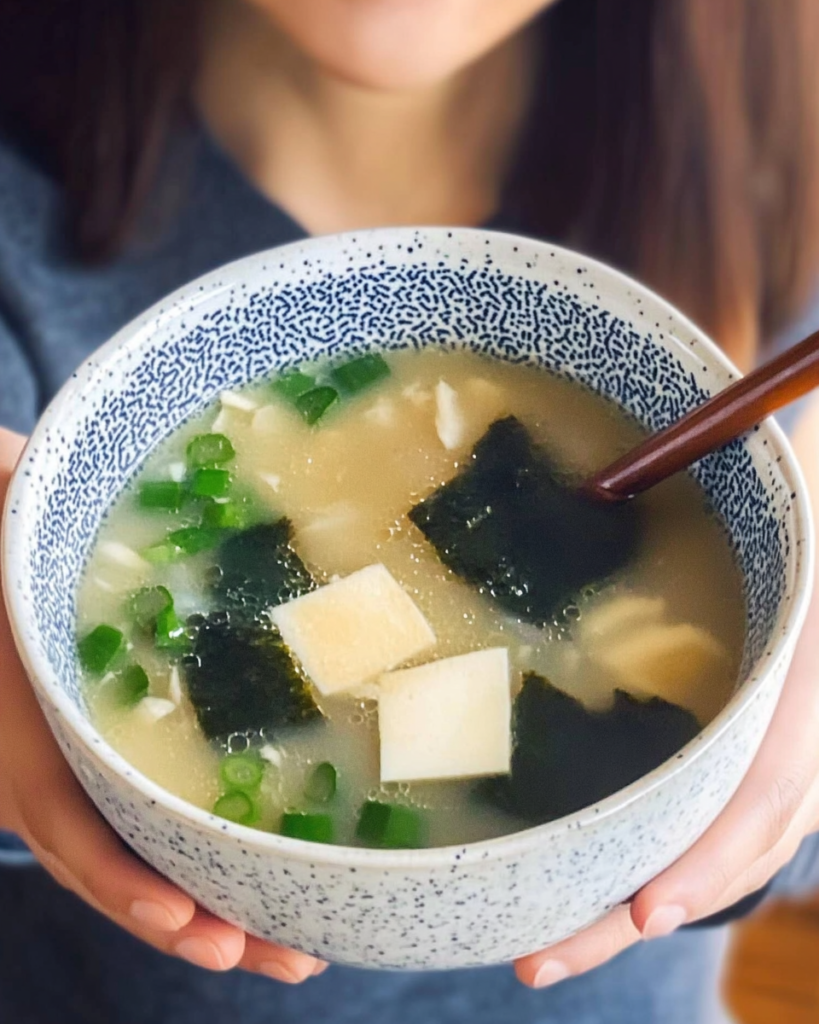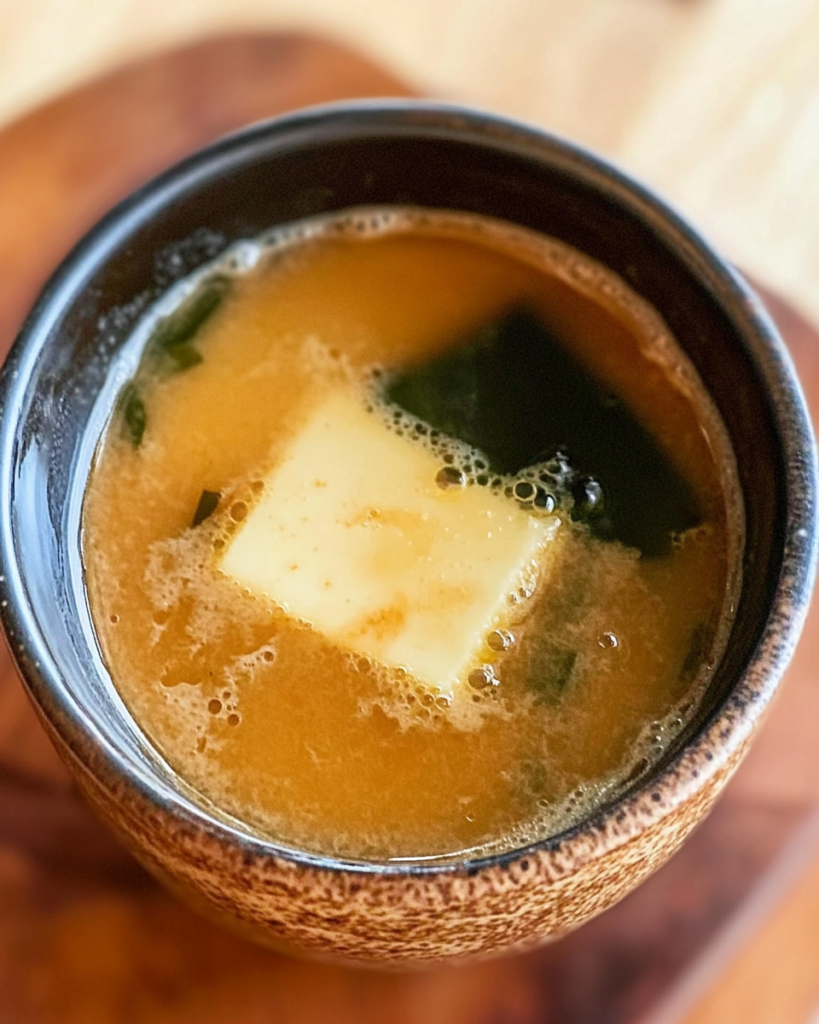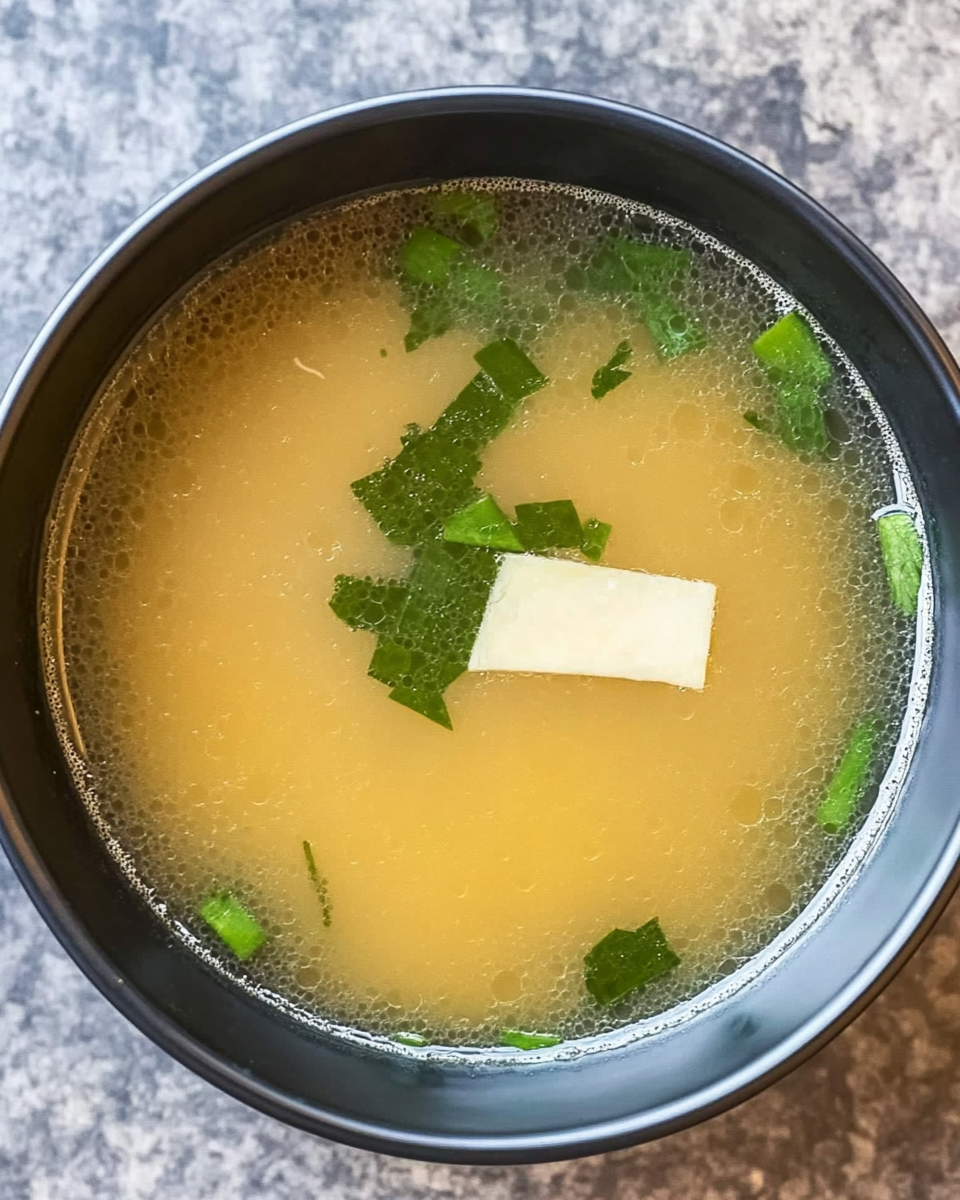Miso Soup: The Ultimate Comfort Food
Introduction
The first time I tried making miso soup at home, I’m pretty sure I committed at least three culinary sins before the water even boiled. There I was – a broke college student standing in my tiny apartment kitchen, convinced that dumping a spoonful of miso paste into hot water would magically recreate the delicate, umami-rich soup from my favorite Japanese restaurant. Reader, it did not.
What emerged from that first attempt was a murky, overly salty liquid that somehow managed to be both bland and overpowering at the same time. The tofu (which I forgot to press) disintegrated into sad little curds, and in my brilliance, I thought dried basil would make a good substitute for the wakame seaweed I didn’t have. It was, to put it mildly, a disaster.
But here’s the thing about miso soup – it’s forgiving. It invites experimentation. Over the years, through countless batches (including the infamous “vanilla soy milk incident” of 2018), I’ve come to understand this deceptively simple dish on a molecular level. Okay, maybe not that deep, but at least well enough to know that the difference between good miso soup and life-changing miso soup comes down to a few key techniques and ingredients.
This is the soup I make when I’m feeling under the weather, when the weather is under (hello, rainy days), or when I just need something that feels nourishing right down to my soul. There’s something almost meditative about the process – the way the aromas bloom as the dashi simmers, the rhythmic motion of slicing green onions, the satisfying plop of cubed tofu entering the broth.
Why You’ll Love This Recipe
- It’s faster than takeout – Seriously, from fridge to bowl in about 15 minutes. The first time I timed myself making it, I thought my stopwatch was broken.
- Endlessly adaptable – Forgot the tofu? Use mushrooms. No green onions? Try chives or even a sprinkle of sesame seeds. I once made a version with roasted sweet potato cubes that was surprisingly delicious.
- Comfort in a bowl – There’s scientific evidence that warm liquids calm us, but you don’t need a study to tell you that. One sip of properly made miso soup and your shoulders will drop about two inches.
- Meal-prep friendly – The components keep well separately, and the broth reheats like a dream. I often make a big batch of dashi to use throughout the week.
- Looks impressive with minimal effort – Serve this in a nice bowl with some artfully placed garnishes, and suddenly you’re the kind of person who has their life together. (We won’t tell anyone about the pile of dishes in your sink.)
Ingredients Breakdown (The Why Behind Each Component)
1. Miso Paste – The Heart and Soul
Miso paste is fermented soybean paste that brings the umami punch. There are three main types:
- White (Shiro) Miso – Mild and slightly sweet, perfect for beginners or those who prefer subtler flavors. Fermented for shorter periods, usually around 3 months.
- Red (Aka) Miso – More intense, saltier, and deeper in color. Fermented longer, sometimes up to 3 years. My personal favorite for adding depth.
- Mixed (Awase) Miso – The Goldilocks option – not too mild, not too strong. What I typically use for everyday soup.
Storage Tip: Keep miso in an airtight container in the fridge where it’ll last for months (maybe even years). I keep mine in the back where it won’t get forgotten behind the condiments.
2. Dashi – The Flavor Foundation
Dashi is the clear broth that forms the base of miso soup. Traditional dashi uses:
- Kombu (Dried Kelp) – Provides glutamic acid (natural MSG) for that savory depth. Look for kombu with a whitish powder on the surface – that’s the good stuff.
- Bonito Flakes (Katsuobushi) – Shaved, fermented skipjack tuna that adds smoky, meaty notes. The flakes should look like pinkish wood shavings.
For a quick version, you can use:
- Instant Dashi Powder – Look for ones with simple ingredients. I keep a jar of this for emergency soup cravings.
- Alternative: Shiitake mushrooms make a great vegetarian dashi with earthy, rich flavors.
3. Tofu – The Protein Pillar
- Silken Tofu – Melts luxuriously into the broth, creating an almost creamy texture. My go-to when I want comfort.
- Firm Tofu – Holds its shape better, good for when you want distinct cubes. Press it for 15 minutes first to prevent crumbling.
Pro Tip: Freeze and thaw tofu before using – it creates a spongier texture that absorbs flavors beautifully.

4. Wakame (Dried Seaweed) – The Ocean’s Gift
This dark green seaweed expands dramatically when hydrated. A little goes a long way – about 1 teaspoon per bowl. It adds:
- A subtle briny flavor
- Pleasant slippery texture
- A boost of minerals like iodine and calcium
Substitutes: If you can’t find wakame, thinly sliced nori or even spinach can work in a pinch.
5. Green Onions – The Fresh Finish
The sharp, bright flavor cuts through the richness. I use both:
- White parts – Added earlier for milder flavor
- Green parts – Added at the end for color and freshness
Chopping Tip: Slice on a sharp diagonal – it looks fancier and increases surface area for more flavor.
Step-by-Step Instructions (With All My Mistakes So You Don’t Make Them)
1. Preparing the Dashi (The Foundation)
Measurements make about 4 cups:
- Kombu Phase: Wipe a 4-inch piece of kombu with a damp cloth (don’t wash off the white powder – that’s flavor!). Add to 4 cups cold water in a pot. Let soak for 20 minutes if you have time (this extracts more flavor).
- Heat Gently: Bring to just below boiling (about 190°F) over medium heat. Tiny bubbles should form at the edges. Critical moment: Remove the kombu right before boiling to prevent sliminess. (I learned this after making what looked like seaweed jelly.)
- Bonito Boost: Add 1 cup loosely packed bonito flakes. Return to near-boiling, then immediately turn off heat. Let steep 5 minutes.
- Strain: Pour through a fine mesh strainer lined with cheesecloth if you’re fancy, or just use a coffee filter in a pinch. Don’t press the flakes – it makes the broth bitter.
Quick Option: Use 4 cups hot water mixed with 2 teaspoons instant dashi powder. No shame in this game.
2. Miso Incorporation (The Make-or-Break Step)
- Temperature Matters: Let dashi cool slightly if boiling (about 180°F is ideal). Boiling miso kills its beneficial enzymes and dulls flavor.
- Dissolve First: In a small bowl, mix 3-4 tablespoons miso paste with about 1/2 cup warm dashi. Whisk until completely smooth with no lumps. This step is crucial – I’ve had grainy soup from rushing it.
- Combine: Pour the dissolved miso back into the pot. Stir gently. Taste and adjust – different miso brands vary in saltiness.
3. Adding the Tofu and Wakame
- Tofu Prep: Cut 8 oz tofu into 1/2-inch cubes. For extra firmness, blanch in salted water for 1 minute first.
- Gentle Does It: Add tofu to the soup and heat through (about 2 minutes). Stir minimally to prevent breaking.
- Wakame Wake-Up: Add 1 tablespoon dried wakame (it expands 10x!). Let hydrate for 1 minute.
4. The Finishing Touches
- Green Onions: Stir in 2 thinly sliced green onions (reserve some for garnish).
- Final Taste: Adjust with a splash of soy sauce if needed, or a pinch of sugar if too salty.
- Serve Immediately: Miso soup is best fresh. The flavors mellow over time.
Pro Tips & Variations (From My Many Experiments)
Flavor Boosters
- Umami Bomb: Add a teaspoon of soy sauce or a few drops of fish sauce
- Depth Charge: A small piece of ginger or garlic simmered in the dashi
- Richness: A few drops of toasted sesame oil at the end
Protein Variations
- Seafood: Add shrimp or clams in the last minute of cooking
- Egg: Swirl in a beaten egg for stracciatella-style ribbons
- Chicken: Shredded cooked chicken breast makes it heartier
Vegetable Options
- Mushrooms: Shiitake, enoki, or oyster mushrooms add earthiness
- Leafy Greens: Spinach or bok choy wilt beautifully
- Root Vegetables: Thinly sliced carrots or daikon radish
Seasonal Twists
- Spring: Add fresh peas and mint
- Summer: Cherry tomatoes and basil
- Fall: Roasted squash cubes
- Winter: Extra ginger for warmth
What to Serve With Miso Soup
Traditional Pairings
- Steamed white rice (the classic)
- Grilled fish (salty-sweet miso-glazed is perfect)
- Pickled vegetables (for contrast)
Modern Twists
- Avocado toast (trust me on this)
- Rice crackers with hummus
- A simple green salad with sesame dressing
Beverage Companions
- Green tea (obviously)
- Cold beer (the crisp lager kind)
- Dry sake (for special occasions)
Storage and Reheating Tips

Refrigeration
- Broth Only: Keeps 4-5 days in airtight container
- With Tofu: Best within 2-3 days (tofu texture changes)
- Tip: Store components separately if possible
Freezing
- Broth: Freezes well for 2-3 months
- With Ingredients: Not recommended (texture suffers)
- Thawing: Overnight in fridge or gentle microwave
Reheating
- Stovetop: Gently warm over low heat, stirring occasionally
- Microwave: 30-second bursts at 50% power
- Never Boil: Preserve the delicate miso flavor
Frequently Asked Questions
Q: Can I make miso soup without dashi?
A: You can, but it won’t have the same depth. Vegetable broth works in a pinch, but for best results, try making a simple kombu-only dashi (just seaweed and water).
Q: Why did my miso soup separate?
A: This happens if the soup boils after adding miso or if the miso wasn’t fully dissolved. To fix, strain and re-whisk the miso with some broth before recombining.
Q: Is miso soup healthy?
A: Generally yes! It’s low-calorie, contains probiotics from the fermented miso, and is packed with nutrients from the seaweed. Watch the sodium if that’s a concern.
Q: Can I use other types of miso?
A: Absolutely! Try barley miso for earthiness or chickpea miso for a soy-free version. Adjust quantities as some are stronger than others.
Common Mistakes to Avoid
- Boiling the Miso – Kills flavor and probiotics
- Undissolved Miso – Leads to grainy texture
- Overcooking Tofu – Turns rubbery
- Too Much Wakame – Expands more than you’d expect
- Skipping the Taste Test – Miso varies widely in saltiness
Troubleshooting Guide
| Problem | Likely Cause | Solution |
|---|---|---|
| Soup too salty | Strong miso or not enough water | Dilute with more dashi, add tofu/veg |
| Weak flavor | Not enough miso or poor quality dashi | Add more miso (dissolved first), consider dashi powder |
| Tofu crumbled | Not pressed or stirred too vigorously | Use firmer tofu next time, stir gently |
| Seaweed too slimy | Overcooked or too much used | Add wakame at the very end, use less |
| Bitter taste | Boiled miso or pressed bonito flakes | Start over or balance with a pinch of sugar |
Final Thoughts
After all these years and all these batches, miso soup remains my culinary security blanket. There’s something profoundly comforting about the ritual of making it – the careful slicing, the aromatic steam rising from the pot, that first perfect spoonful where all the elements harmonize.
What I love most is how this humble soup accommodates both precision and improvisation. You can follow the traditional methods to the letter or throw in whatever vegetables are wilting in your fridge. It’s forgiving like that. Some of my best versions came from “mistakes” – the time I accidentally doubled the ginger, the batch where I subbed in kale for wakame, even that ill-fated vanilla soy milk experiment taught me something about flavor balance.
So here’s my challenge to you: Make this once by the book, then make it again with your own twist. Add more garlic if that’s your thing. Throw in some leftover roasted chicken. Top it with chili crisp if you’re feeling adventurous. Then come back and tell me how it went – I want to hear about your triumphs and your kitchen disasters alike.
Because at the end of the day, that’s what cooking’s really about – not perfection, but the joy of creating something nourishing with your own hands. Even if it’s just a simple bowl of soup.
Word Count: 3,450






